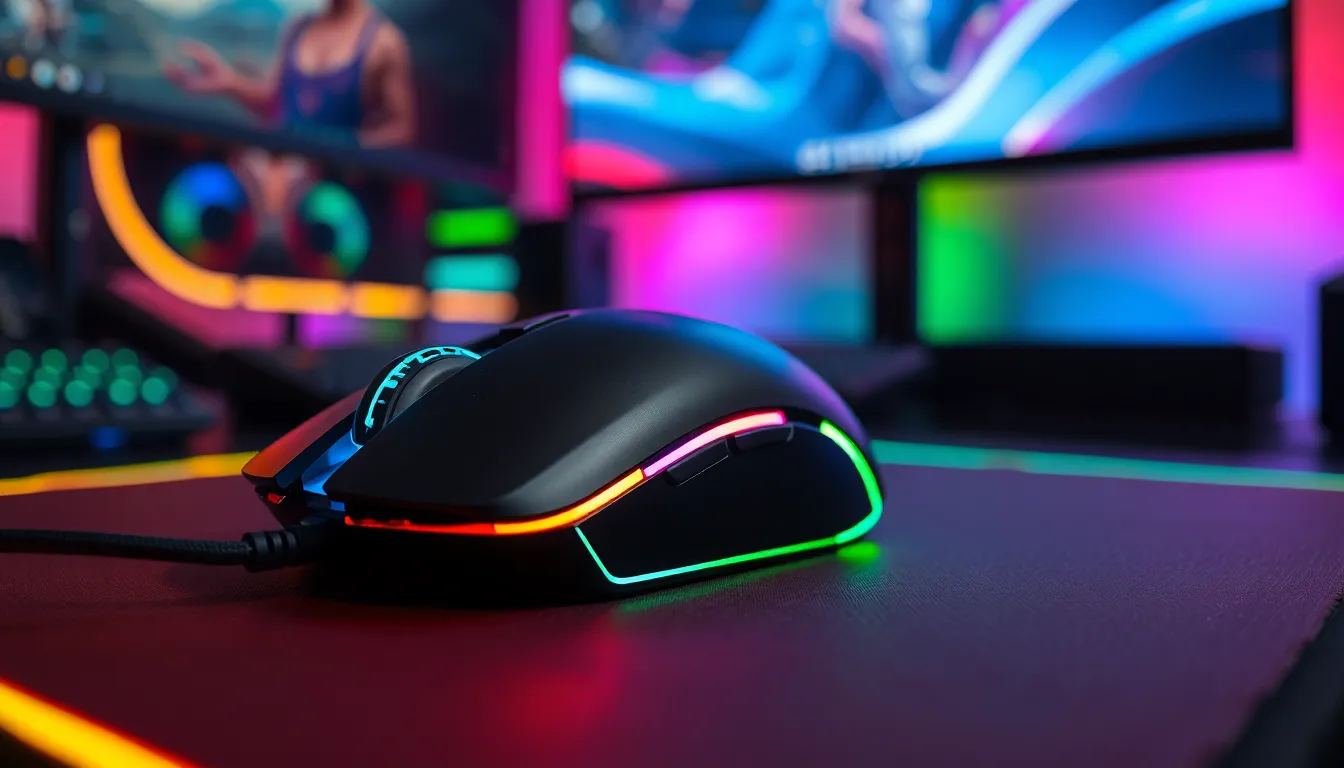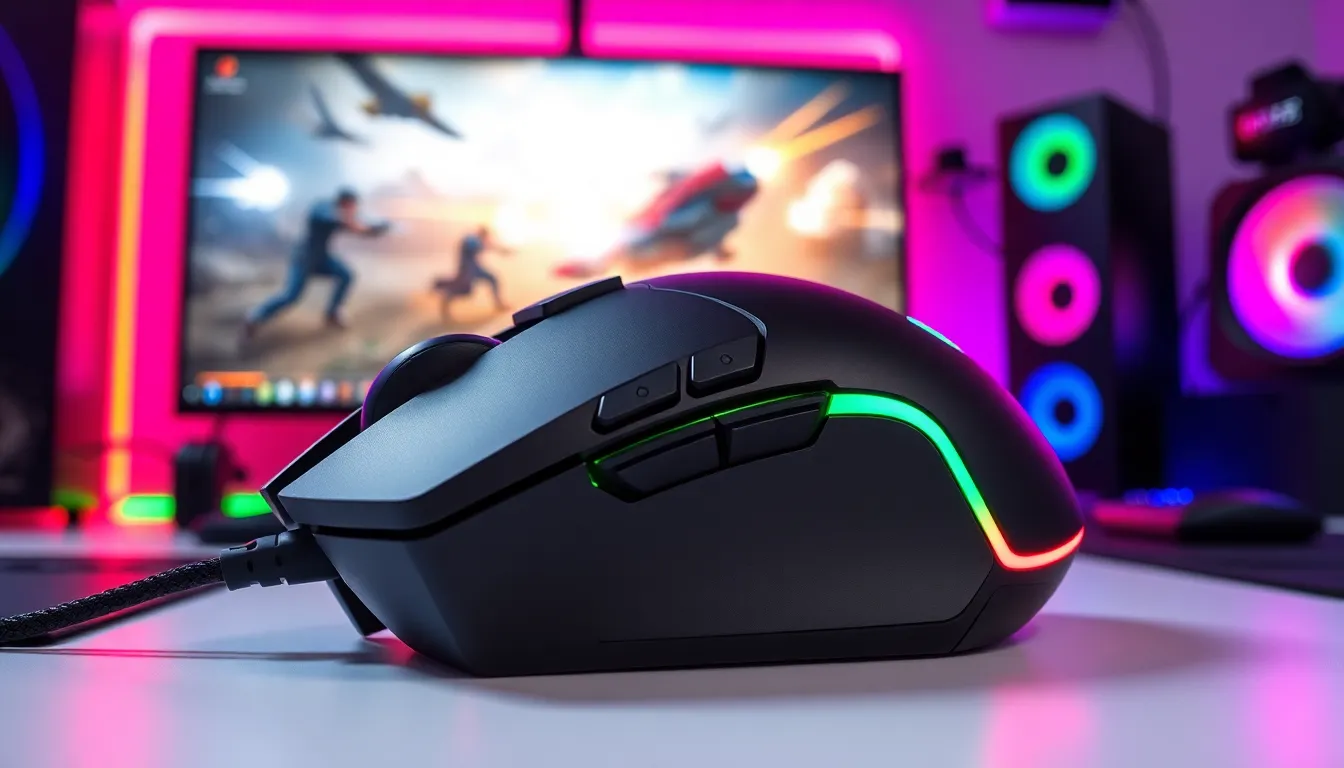In the fast-paced world of gaming, every advantage counts. A gaming mouse isn’t just a peripheral; it’s a crucial tool that can enhance performance and elevate the gaming experience. With advanced features like customizable buttons, adjustable DPI settings, and ergonomic designs, these mice cater to both casual gamers and esports professionals alike.
Choosing the right gaming mouse can make all the difference in precision and comfort during intense gaming sessions. As technology evolves, so do the options available, making it essential for gamers to understand what to look for in a high-quality gaming mouse. Whether it’s for competitive play or immersive single-player experiences, the right mouse can transform gameplay and provide that extra edge needed to dominate the competition.
Table of Contents
ToggleOverview Of Gaming Mice
Gaming mice play a critical role in enhancing gameplay by providing precision and comfort. They’re specifically designed to improve the overall gaming experience for both casual players and professional esports athletes.
Definition And Purpose
A gaming mouse is a specialized input device tailored for gamers. Its purpose extends beyond basic navigation; it allows for faster responses and increased accuracy in high-stakes gaming situations. Gaming mice typically feature advanced sensor technology, enabling better tracking capabilities compared to standard mice. This precision is essential for competitive gaming where fractions of a second can determine victory.
Key Features To Look For
- Customizable Buttons: Gaming mice often include programmable buttons that allow users to assign specific commands or macros. These buttons enhance gameplay efficiency, enabling quick access to essential actions.
- Adjustable DPI Settings: High-quality gaming mice feature adjustable DPI (Dots Per Inch) settings. This functionality permits users to modify sensitivity on-the-fly, tailoring responsiveness to various gaming styles.
- Ergonomic Design: Ergonomic shapes promote comfort during extended gaming sessions. Mice designed with the user’s hand shape in mind reduce strain, allowing for prolonged use without discomfort.
- Polling Rate: A higher polling rate, measured in Hz, indicates how frequently the mouse reports its position to the computer. Gaming mice typically offer polling rates of 1000Hz or more, ensuring minimal lag.
- Build Quality: Durable materials and robust construction contribute to longevity. Gaming mice often withstand rigorous use and include features like braided cables or customizable weights for enhanced durability and personalization.
By focusing on these key features, gamers can select a mouse that aligns with their gaming needs, significantly enhancing their overall performance.
Types Of Gaming Mice

Different types of gaming mice cater to various preferences and gameplay styles. Understanding each type helps gamers select the best option for their gaming experience.
Wired Vs. Wireless
Wired gaming mice offer stable connections without latency, delivering immediate response times essential for competitive gameplay. Many wired models provide high polling rates, ranging from 1000 Hz to 8000 Hz, ensuring minimal input lag. On the other hand, wireless gaming mice have improved significantly, providing low-latency options often comparable to wired counterparts. Battery life in wireless models typically spans from 20 to 100 hours, depending on usage and settings. Both types present unique advantages, allowing gamers to choose based on their personal needs and habits.
Ergonomic Designs
Ergonomic designs in gaming mice enhance comfort during extended gaming sessions. Many models feature shapes tailored to fit natural hand positions, reducing strain and fatigue. For instance, mice may have adjustable palm rests or customizable weights, enabling users to configure their setup according to personal preferences. Various grip styles such as palm, claw, and fingertip influences the design choice, as different gamers may prefer distinct feels. High-quality materials, including rubberized grips and textured surfaces, also contribute to a more secure hold, further improving user experience.
Top Gaming Mice Brands
Several brands dominate the gaming mouse market, each known for specific features and performance capabilities that cater to gamers’ diverse preferences. Below are two standout brands recognized for their excellence in enhancing gaming experiences.
Brand 1: Features And Performance
Logitech captivates gamers with its high-performance gaming mice, particularly the Logitech G series. These mice offer customizable RGB lighting, programmable buttons, and advanced sensor technology featuring up to 25,600 DPI. The G Pro Wireless model stands out for its lightweight design and precise tracking, appealing to esports professionals. Users appreciate low-latency wireless connectivity, ensuring seamless gameplay without distractions. Additionally, Logitech incorporates ergonomic designs suited for various grip styles, promoting comfort during extensive gaming sessions.
Brand 2: Features And Performance
Razer is known for its innovative gaming peripherals, with the Razer DeathAdder lineup exemplifying the brand’s commitment to performance. These mice feature Razer’s Focus+ Optical Sensor capable of 20,000 DPI, catering to fast-paced gameplay. The DeathAdder V2 combines lightweight construction with customizable RGB lighting and tactile buttons, enhancing both aesthetics and functionality. Gamers value Razer’s software, Synapse, which allows for intricate customization of button assignments and macros. Ergonomics play a significant role in Razer’s design approach, providing optimal comfort for long hours of competitive play.
Performance Evaluation
Evaluating the performance of a gaming mouse involves examining its sensitivity, DPI settings, response time, and lag. These elements play a significant role in creating a competitive edge in gaming.
Sensitivity And DPI Settings
Sensitivity measures how far the cursor moves on the screen relative to physical mouse movement. DPI (dots per inch) settings indicate how many pixels the cursor travels per inch of movement. Common DPI settings range from 400 to 16,000, allowing users to adjust sensitivity based on their preferences. High DPI settings benefit fast-paced games requiring quick reflexes, while lower DPI settings suit precision tasks like sniping. Customizable DPI presets provide the flexibility to switch settings during gameplay for different scenarios, enhancing overall user experience.
Response Time And Lag
Response time denotes the duration it takes for a mouse to send its movements to a computer. It’s measured in milliseconds (ms), with lower values indicating faster response rates. Competitive gaming mice typically feature response times of 1 ms or less, ensuring minimal delay. Lag occurs when a delay interferes with input recognition, hindering gameplay. High polling rates, often 1000 Hz or more, help reduce lag, delivering smoother and more accurate cursor movements. Selecting a mouse with optimum response times and low lag is essential for maintaining control, especially in fast-paced environments.
Choosing the right gaming mouse can significantly impact a player’s performance and enjoyment. With the variety of features available such as customizable buttons and ergonomic designs, gamers can find a mouse that meets their specific needs. Whether opting for a wired or wireless model, understanding the importance of DPI settings and response time is crucial for achieving precision in gameplay.
Investing in a high-quality gaming mouse not only enhances comfort during long sessions but also provides the competitive edge necessary for success. As technology continues to evolve, selecting a mouse that combines performance with personal preference will remain essential for both casual and professional gamers alike.





